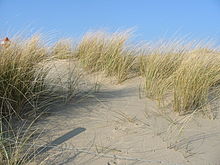| Ammophila | |
|---|---|

| |
| European marram grass Dunes near The Hague, February | |
| Scientific classification | |
| Kingdom: | Plantae |
| Clade: | Tracheophytes |
| Clade: | Angiosperms |
| Clade: | Monocots |
| Clade: | Commelinids |
| Order: | Poales |
| Family: | Poaceae |
| Genus: | Ammophila Host[1] |
| Species | |
| |

| |
| The range of Ammophila in North America | |
Ammophila (synonymous with Psamma P. Beauv.) is a genus of flowering plants consisting of two or three very similar species of grasses. The common names for these grasses include marram grass, bent grass, and beachgrass.[2] These grasses are found almost exclusively on the first line of coastal dunes. Their extensive systems of creeping underground stems or rhizomes allow them to thrive under conditions of shifting sands and high winds, and to help stabilize and prevent coastal erosion. Ammophila species are native to the coasts of the North Atlantic Ocean where they are usually the dominant species on dunes. Their native range includes few inland regions, with the Great Lakes of North America being the main exception.[3] The genus name Ammophila originates from the Greek words ἄμμος (ámmos), meaning "sand", and φίλος (philos), meaning "friend".
The Ammophila grasses are widely known as examples of xerophytes, plants that can withstand dry conditions. Despite their occurrence on seacoasts, Ammophila grasses are not particularly tolerant of saline soils; they can tolerate a salinity of about 15 g/L (1.5%), which makes them "moderate halophytes".[4]
Ammophila builds coastal dunes and thus stabilizes the sand. For this reason, the plants are seen as a useful means of reinforcing dunes around the world and have been introduced far from their native range. Alfred Wiedemann writes that Ammophila arenaria, the European species, "has been introduced into virtually every British colonial settlement within its latitudinal tolerance range, including southeast and southwest Australia, New Zealand, South Africa, the Falkland Islands, and Norfolk Island and has been reported from Argentina and Chile."[5] Ammophila species were introduced in the late 19th century on the Pacific coast of North America as well, and massive, intentional plantings were continued at least through 1960.
In essentially all of the locations where they have been introduced, Ammophila plants are now listed as invasive. Ammophila infestations largely impact coastal groundbirds and endemic dune plants, such as the Western Snowy plover, Streaked Horned lark (Eremophila alpestris strigata), and pink sand verbena (Abronia. umbellata ssp. breviflora).[6] In California, efforts to cull invasive Ammophila arenaria from Morro Strand State Beach began in 2000 and involved a combination of herbicide treatments and handpulling by a California Conservation Corps crew. This initiative produced 60 percent mortality among the Ammophila after several months, but it was estimated that several additional rounds of treatment would be needed to fully remove the infestation, and the effort specifically focused on "relatively new infestations."[7] Bulldozing has also been used as an effective mechanical treatment for Ammophila infestations in the Pacific Northwest, but research indicates that the intensity and frequency of bulldozing employed to remove Ammophila may also harm endemic dune plants and have negative impacts on dune geomorphology.[6]
- ^ "Species in GRIN for genus". www.ars-grin.gov. Archived from the original on 2008-10-11. Retrieved 2008-04-24.
- ^ "Ammophila". Integrated Taxonomic Information System. Retrieved 19 September 2008.
- ^ Preston, C. D.; Pearman, D. A.; Dines, T. D. (2002). New Atlas of the British and Irish Flora. Oxford University Press. ISBN 978-0-19-851067-3.
- ^ "Comprehensive Report Species - Ammophila arenaria". NatureServe. Archived from the original on 2009-07-25. Retrieved 2008-09-28.
- ^ Wiedemann, Alfred (1998-02-12). "Ammophila arenaria on the northwest coast of North America". Botanical Electronic News - BEN #183. Archived from the original on 27 September 2008. Retrieved 2008-09-19.
- ^ a b Zarnetske, Phoebe; Seabloom, Eric; Hacker, Sally (November 24, 2010). "Non-target effects of invasive species management: beachgrass, birds, and bulldozers in coastal dunes". Ecosphere. 1 (5): 1–20 – via Wiley Online Library.
- ^ "Beach Grass Removal Project". California Department of Parks and Recreation. Retrieved November 7, 2024.